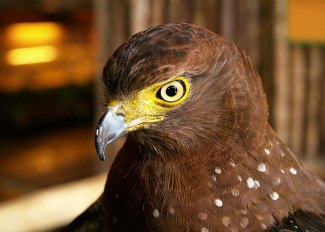Philippine Serpent Eagle - Spilornis holospilus
By Charles P. Laigo, CC-BY-SA-3.0, via Wikimedia Commons
Family: Accipitridae
Genus: Spilornis
Species: S. holospilus
Philippine Serpent Eagles are relatively small raptors that live on Luzon Island and Mindano Island in the Philippines and occur in a range of habitats.
Physical Description:
Philippine Serpent Eagles are brown from above and have a short bushy crest, black crown, and gray to gray-brown cheeks and throat. The underparts are rufous with white spots that merge into barring along the crissum. The tail is black with a white tip, light brown central band, and a secondary basal band. The primary feathers are also black and there is white spotting along the wing coverts. The eyes, legs, and lores are yellow.
Juveniles are brown from above with rufous to buff edges and they have a white crown. The mantle is streaked and spotted with brown and there are two dark patches behind the eyes. The feathers along the wing-coverts are white at the base and the tail is dark brown with a light-colored tip and three brown bands. The undertail is gray-white. Underparts are cream to white with heavy rufous markings along the breast and paler rufous streaking along the belly and thighs. Eyes are gray.
Their call is a sharp rising and falling whistle. Listen to a Philippine Serpent Eagle.
Size:
Length: 47-53 cm
Wingspan: 105-120 cm
Habitat and Distribution:
They live in riparian forest, foothills, open country including cultivated areas, and along forest edges from 0-2,500 meters above sea level, though usually below 1,500 m. They are often seen soaring above the forest.
They live on the islands of Luzon and Mindanao in the Philippines, from 18.5°N to 6°N. Adults are most likely sedentary throughout their range. There are an estimated 10,000 individuals.
By markaharper1, CC-BY-SA-2.0, via Wikimedia Commons
Diet and Hunting:
Philippine Serpent Eagles, as their name would suggest, eat snakes, and also lizards.
Reproduction:
The nest and eggs are undescribed. The egg-laying season is probably around April, since a bird with an egg in its oviduct was found during that month.
Conservation:
They are common within their range but threatened by habitat loss, despite the fact they are more capable of adapting to changing environments than some eagle species. They are currently listed as Least Concern by BirdLife International.
Taxonomy:
Spilornis holospilus is treated as a subspecies of Spilornis cheela (Crested Serpent Eagle) by some authorities, but it categorized as a full species by BirdLife International and Ferguson-Lees, James and Christie, David A. (2001).
Other Names:
Orlík filipínský (Czech), Filippinsk Slangeørn (Danish), Filipiini maduhaugas (Estonian), Serpentaire des Philippines (French), Philippinenschlangenweihe (German), Serpentario delle Filippine, Fuiripinkanmuriwashi (Japanese), Filippinersnokørn (Norwegian), Wezojad filipinski (Polish), Filippinsk tofsormörn (Swedish).
Video of a Philippine Serpent Eagle:
References:
http://avibase.bsc-eoc.org/species.jsp?avibaseid=B7C2D213E6FF7848
BirdLife International (2012) Species factsheet: Spilornis holospilus. Downloaded from http://www.birdlife.org on
10/02/2012.
Global Raptor Information Network. 2012. Species account: Philippine Serpent Eagle Spilornis holospilus. Downloaded from
http://www.globalraptors.org on 10 Feb. 2012
http://ibc.lynxeds.com/species/philippine-serpent-eagle-spilornis-holospilus
BirdLife International 2009. Spilornis holospilus. In: IUCN 2011. IUCN Red List of Threatened Species. Version 2011.2.
www.iucnredlist.org. Downloaded on 10 February 2012.
Ferguson-Lees, James, and Christie, David A. Raptors of the World. Houghton Mifflin Company, 2001.

